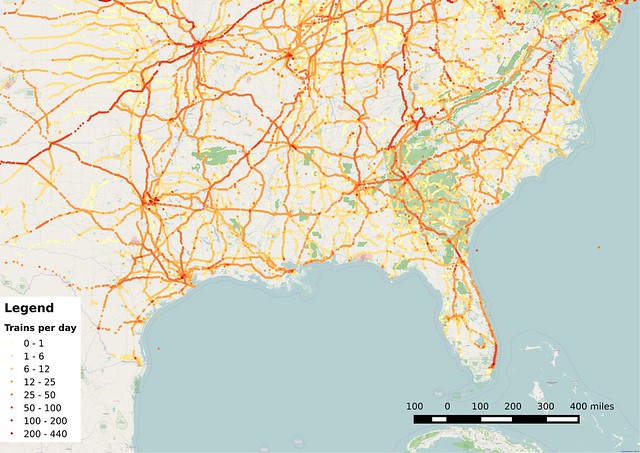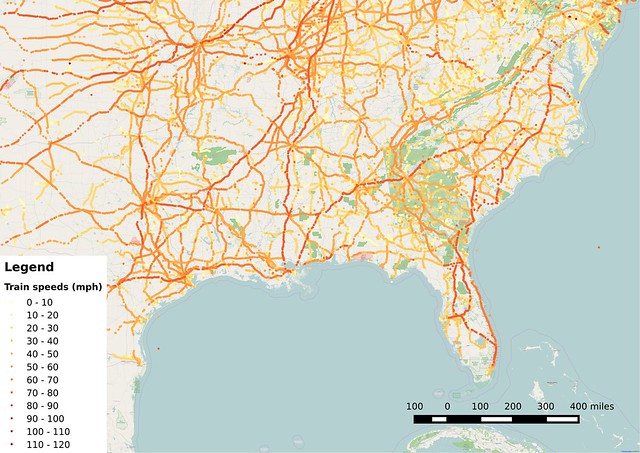What could have damaged tracks so badly that it would still be out of service ten years later? Even though Katrina was the deadliest storm to hit the U.S. since 1928, was its impact so great that we couldn't restore the modest service that was running before the storm? In reality, the hurricane is probably just a convenient excuse for the halt of passenger operations and not an outcome that should be tolerated.
Surprisingly, when Amtrak formed in 1971, the system didn't include any service between New Orleans and northern Florida. It took over two decades of campaigning by the region before a direct link was reestablished in 1993. Even when the train did run on the line, it was only three times a week each direction—the same frequency that it's always had on the route's western section from Los Angeles to New Orleans.
I decided to take a look at the layout of tracks along the route to try and understand why it has continued to take so long, using a map format like what I used on the Empire Builder route several months ago. I focused on the 770-mile stretch that is still suspended between New Orleans and Orlando.
When I started, I expected to find something obviously out of place along the route, but as I traced the line through Louisiana, Mississippi, Alabama, and Florida, everything seemed to be in good order.
However, it was obvious from the aerial imagery that there were a few different sections to the corridor which carry different amounts of traffic and are maintained to different standards. I compared my map to railroad crossing data from the Federal Railroad Administration (which I used to make the map in my previous post) and made note of these five main segments:
- Starting from the west, the Sunset Limited used mainline tracks that run from New Orleans to Mobile, Alabama, and then toward Montgomery, though the train turns off the mainline in the small town of Flomaton, Alabama, right next to the border with Florida. For this distance of about 210 miles, the track see about 15 to 18 freight trains per day. The FRA railroad crossing database still lists top speeds up to 79 mph, which is the maximum for most passenger rail lines across the U.S. The longest distance I found between sidings was 13.8 miles.
- From Flomaton, the line heads south to Pensacola, Florida and then east to Tallahassee, covering a distance of about 240 miles. This section of the line is much quieter, only seeing two or three trains per day. Speeds appear to range from 30 mph up to 59 mph, a number that signifies that the line lacks any illuminated signals to help control train movements. The longest distance between sidings here is 31.1 miles
- For the next 105 miles from Tallahassee to Lake City, there are about 7 trains per day, and top speeds now appear to be about 40 mph in most places (which appears to be a reduction in speed from before the storm in 2005). The longest stretch between sidings is 18.4 miles.
- The 62 miles from Lake City to Jacksonville host 8 to 12 trains per day and have speeds up to 79 mph, with the longest single-track segment being 12.5 miles.
- The 151 miles from Jacksonville to Orlando still has three Amtrak passenger trains in operation, the Silver Meteor, Silver Star, and the Auto Train (an oddball route that only stops in the Orlando suburb of Sanford). The FRA data indicates there are 8-14 trains per day in total, though it doesn't seem to include traffic from the new SunRail commuter service near Orlando. the spacing between sidings is fairly short, only reaching up to 11 miles apart. Most of the commuter rail section near Orlando is double-tracked.
Just east of New Orleans, the tracks cross the Intracoastal Waterway, which connects Lake Pontchartrain to the Gulf of Mexico. The line then passes into Mississippi and through communities such as Bay St. Louis, Pass Christian, and Biloxi, which were among the places hit hardest by the wind and storm surge during the hurricane. In Pass Christian, the surge measured 27.8 feet and was combined with a relatively high tide.
That level of surge is enough to completely obliterate homes and other modest-sized buildings. The rail line suffered too as tracks were washed out and bridges destroyed and electrical signaling huts that were flooded with saltwater as the water crashed ashore. In some places, ships and barges floated up onto the ground and eventually settled onto tracks as the waters receded.

About 100 miles of track was severely damaged or destroyed, but with 15 to 18 trains per day, it was important for the railroad to be repaired and brought back into service. The railroad and several contracting companies worked for four months to restore service between New Orleans and Mobile.
It's less clear how bad the situation was in Florida, along the second notable section of track in my list. Pensacola did experience a modest storm surge of about five feet, but that didn't cause as much damage, so the line was back in operation pretty quickly. Only the track nearest Pensacola would have been affected by storm surge—most of the distance from Flomaton to Tallahassee is inland and would have only been damaged by wind and creeks and rivers swollen by rain.
And yet, this relatively protected stretch of track is probably the real culprit preventing the resumption of service. With only two or three trains per day, there isn't enough revenue from freight traffic to warrant maintaining tracks at the level that passenger trains really need.
I was surprised to see that train frequencies were so low along that stretch of track, since the Gulf Coast seems like an important economic region to me. But rail freight tends to move in a more hub-and-spoke pattern like airlines rather than a point-to-point service like highway vehicles do.

A line with just two or three freights per day often only justifies enough maintenance to operate at speeds of 10 to 30 miles per hour, which is far too low for passenger services. Extra outside funding is often needed to cover the cost gap when passenger operations exist on otherwise quiet lines. That's likely one of the reasons why Sunset Limited service hasn't resumed: Either previous funding sources dried up, or the railroad increased the amount of money they were asking for after the hurricane and subsequent repair work.
Running more trains, whether freight or passenger, would allow the cost to be spread more widely, but that idea hasn't gotten much traction so far. Amtrak studied the route back in 2009, but only looked at either restoring the previous tri-weekly train or two options for running a daily service (one was an extension of the City of New Orleans from Chicago, while the other was a standalone New Orleans to Orlando train).
Amtrak's underwhelming conclusion? Restore the train as it had been before, despite it's infrequent service and all the delays and complication involved in running a train all the way from coast to coast.
Studies like that are asking the wrong question and getting the wrong answer. What the country really needs is for Amtrak to add frequent, speedy service so that their trains can be used as day-to-day transportation for many more people. That would broaden the benefits that the company provides, and hopefully reduce their operating losses as well.
Here are populations for some of the metropolitan areas from New Orleans on east to Orlando:
- New Orleans region - 1.2 million
- Gulfport region - 383,000
- Mobile region - 414,000
- Pensacola region - 461,000
- Tallahassee region - 376,000
- Jacksonville region - 1.4-1.5 million
- Orlando region - 2.3-3.0 million
Still, there are a few shorter segments that look good on paper. Here in Minnesota, we've been looking at adding eight daily round-trips on the 150-mile Northern Lights Express corridor from Minneapolis to Duluth. The Twin Cities has a population up to 3.5 or 3.8 million, and the Duluth area has a population around 280,000.
Orlando and Jacksonville two 1-million-plus metros about 150 miles apart, which makes that corridor an ideal candidate for increased rail service. New Orleans-Gulfport-Mobile and Jacksonville-Tallahassee are also pretty similar distances (144 and 167 miles, respectively).
Having multiple daily trips on the eastern and western segments would probably improve the viability of the middle section of the line, the most likely source of trouble today. The service improvements might even justify a new, more direct rail alignment between Mobile and Pensacola.
Similarly, if we look to cities west of New Orleans, there are some interesting combinations possible if the line started in Texas:
- Baton Rouge region - 820,000
- Lafayette region - 479,000 to 616,000
- Houston region - 6.3 million
- San Antonio region - 2.3 million
Amtrak's trouble with restoring the Sunset Limited or pursuing even better options shares the same symptoms that the company has all across the country. They've lacked the funding and motivation to pursue service improvements in areas that would bring the biggest bang for the buck while also adding to the system's overall connectivity. Amtrak needs better funding to pursue these opportunities, otherwise we'll look back in a couple decades and still find a skeletal national network that hardly looks different than what we have today.
No comments:
Post a Comment